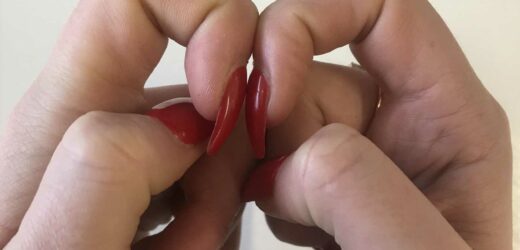IT'S one of the UK's deadliest killers – but there is a simple test you can do to help predict your risk of lung cancer.
It takes the lives of around 96 people every day and is the fifth biggest cause of death in England.
Around 47,000 people are diagnosed with the condition every year in the UK.
As with any forms of the disease, the earlier it's diagnosed, the better.
This is where the simple 'diamond gap' finger test can help.
It's also known as the Schamroth window test and could help you spot lung cancer early.
Read more on lung cancer
Urgent warning over surprising cancer risk you’ve probably never heard of
The 2 clues your ‘harmless’ cough could be a sign of deadly cancer
It involves putting your nails together to see if there's a diamond-shaped space between your cuticles.
If there isn't, this indicates finger clubbing.
Finger clubbing is when the tips of the digits enlarge, causing the nails to curve.
This is a common symptom of lung cancer, occuring in more than 35 per cent of people with the disease, according to Cancer Research UK.
Most read in Health
12 steps to losing weight fast, according to the NHS
How a simple thumb test can reveal if you’re at risk of deadly illness
It took 5 months to see a GP about a nasty cough – I'm facing a death sentence
I’m a doctor – here’s the real reason you don’t poo yourself when you fart
It's worth noting that finger clubbing doesn't necessarily mean you definitely have lung cancer – and there are lots of reasons why your fingers may present this way.
Nail or finger clubbing can be the result of many conditions, like cystic fibrosis, heart disease, Crohn's, other cancers or is hereditary.
But lung cancer is responsible for about 80 to 90 per cent of finger clubbing cases.
If you have finger clubbing, it is important to rule out cancer so make sure you see your GP as soon as possible to establish the cause.
How to do the test
Put the nails of your index fingers together, back-to-back.
Look for a tiny diamond-shaped space between your cuticles, where the light is coming through.
If there isn't space, and the nailbeds are touching, this is a sign of finger clubbing.
The ends of the fingers may be larger than usual, and the nails curved.
Finger clubbing is thought to be caused by increased blood flow to the finger area.
It leads to the accumulation of fluid in the soft tissues at the ends of the fingers – but it’s not entirely clear why this happens.
Changes in the nail tends to happen in stages.
The base of the nail becomes soft and the skin next to the nail bed becomes shiny before the nails begin to curve more than normal.
A grandmother has desribed how she was diagnosed with lung cancer after spotting her nails had become curved.
Cancer types, signs and symptoms
Everything you need to know about different types of Cancer
Bowel cancer symptoms: What are they and when should I start to worry?
What is prostate cancer? Signs and symptoms of the condition
What are skin cancer symptoms and what does the disease look like?
How to check your breasts for signs of cancer
Stomach cancer: Symptoms, causes, and treatments
What is a brain tumour and what are the symptoms?
What does a cancerous mole look like?
What are esophageal cancer symptoms?
Is skin cancer itchy?
How to tell the difference between haemorrhoids and cancer
Are sunbeds safe and can they cause cancer?
What is glioblastoma and what are the symptoms?
Jean Taylor had brushed off her "ugly" nails as nothing more than an embarrassing trait before getting her devastating diagnosis.
She has urged people to take the diamond gap finger test so that people can catch lung cancer early.
Unfortunately, lung cancer is often diagnosed late because it doesn't usually cause noticeable symptoms until it has spread through the lungs or into other parts of the body.
This means that for many people the cancer has already spread when they are diagnosed.
Read More on The Sun
Two-bed home could be yours for a low £4k – but it’s missing a key feature
I’m a cleaning pro, 4 products you should ditch that are a waste of money
In general, about one in three people with the illness live for at least a year after they're diagnosed and about one in 20 people live for at least ten years.
However, it is worth noting that survival rates can vary widely, depending on how far the cancer has spread at the time of diagnosis –early diagnosis can make a big difference.
Lung cancer symptoms
WHAT are the other symptoms of lung cancer?
Not all people with lung cancer have finger clubbing as a symptom.
Other signs to look out for include:
- Having a cough most of the time
- A change in a cough you have had for a long time
- Being short of breath
- Coughing up phlegm which has signs of blood
- Aches or pains in the chest or shoulder
- Loss of appetite
- Tiredness
- Weight loss
Source: Read Full Article














